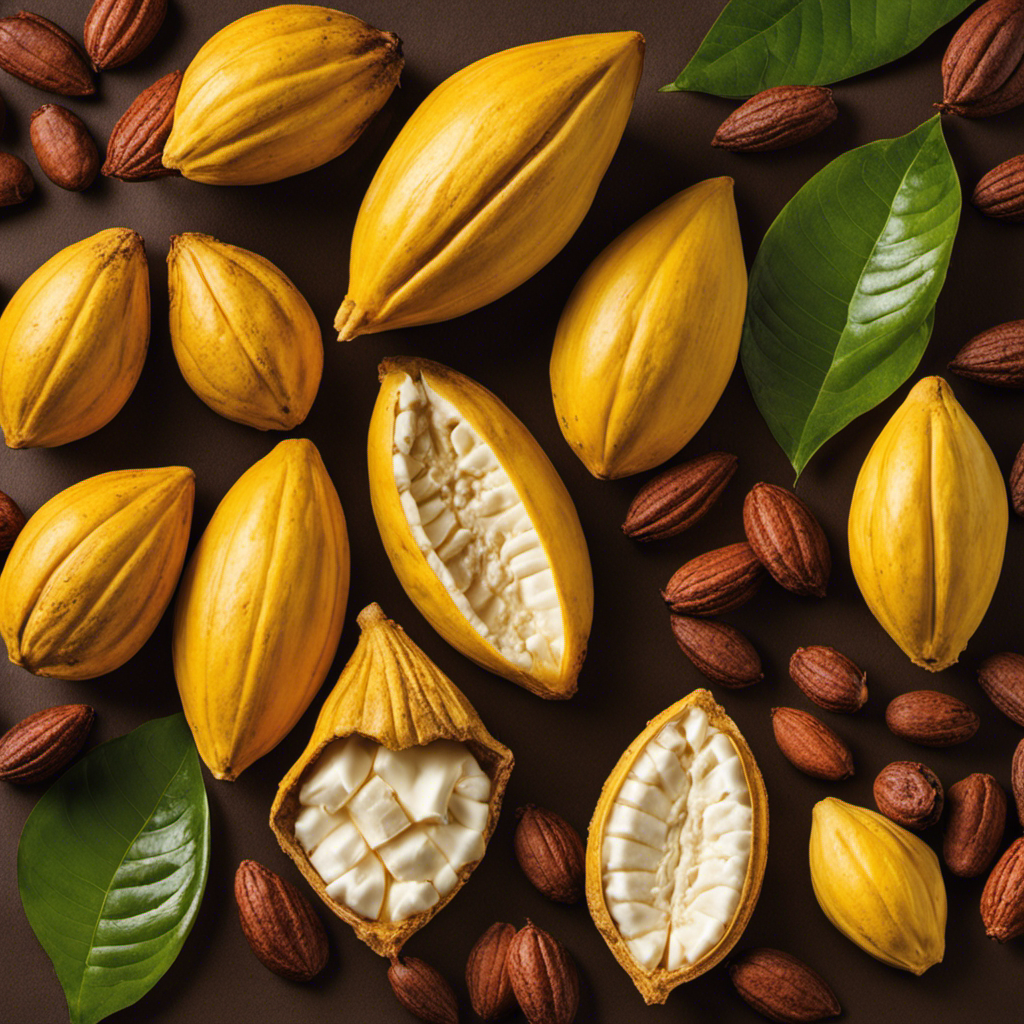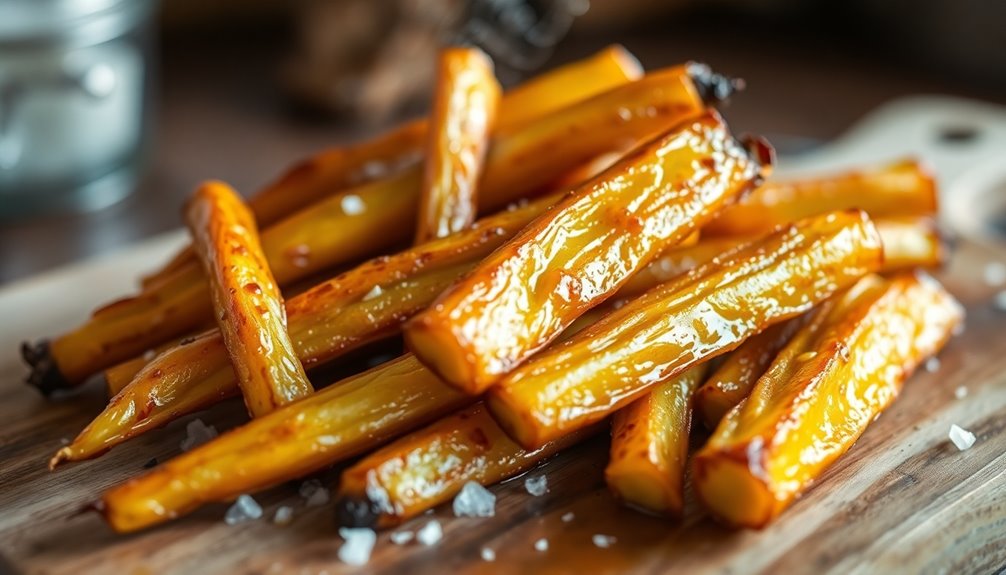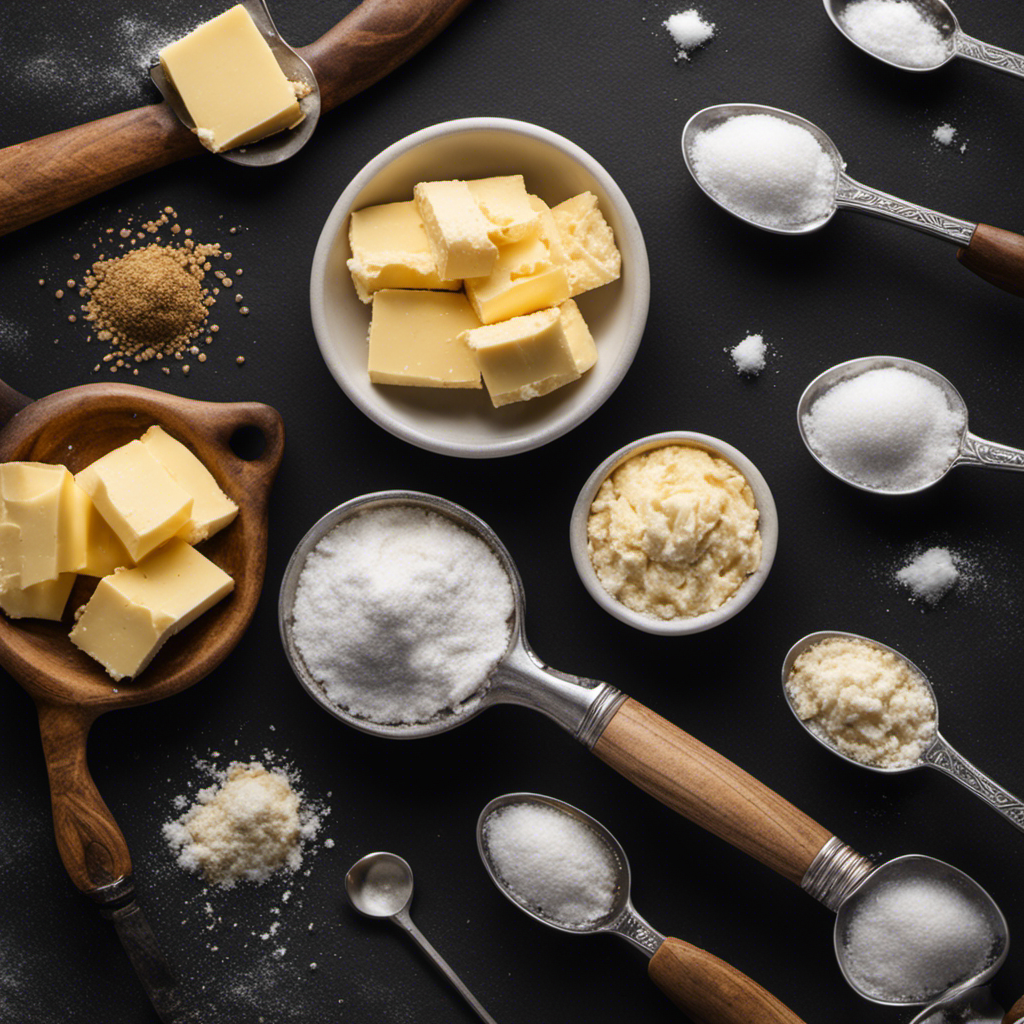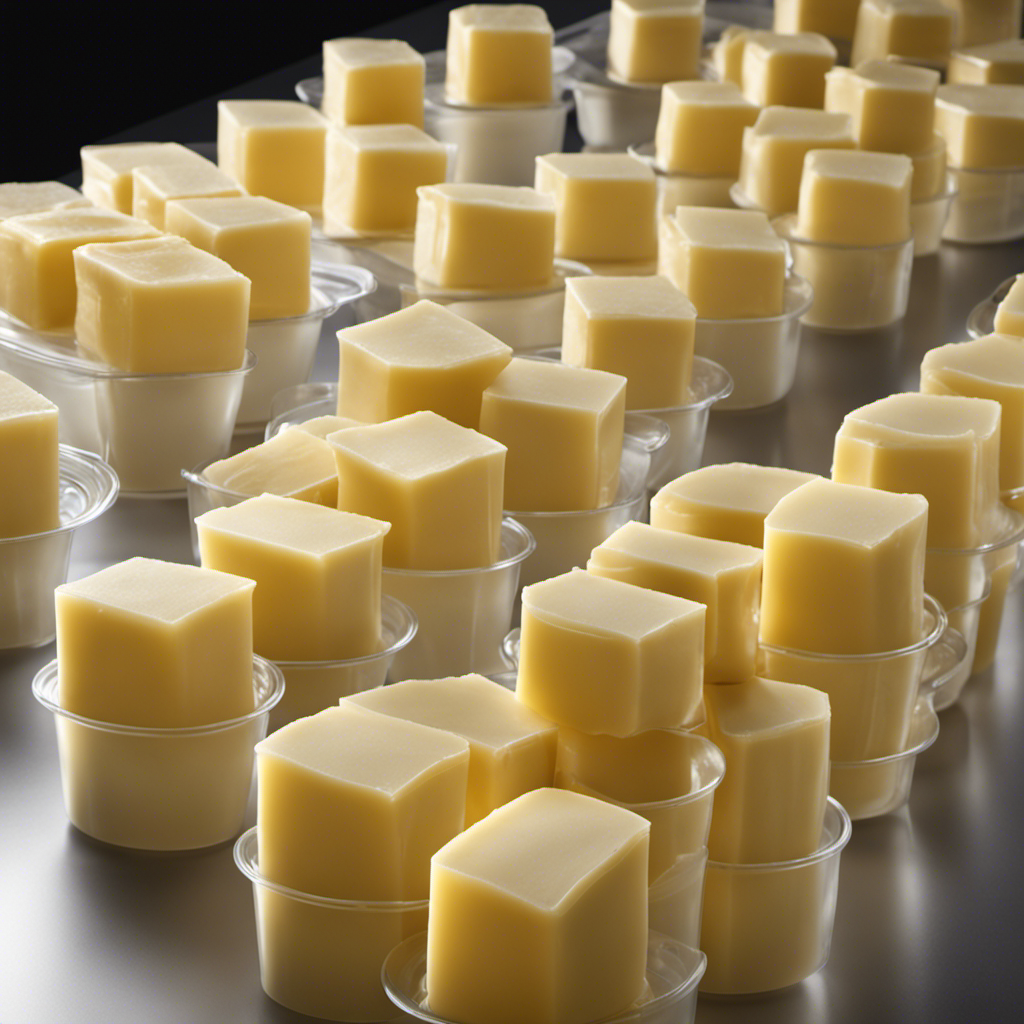As a passionate chocolate enthusiast, I have frequently pondered the enchanting process of turning cocoa beans into the creamy and luxurious cocoa butter that enhances our beloved indulgences.
In this article, I will guide you through the steps of making cocoa butter, from extracting it from the cocoa beans to refining and preserving it.
Join me on this journey as we unravel the secrets behind this delectable ingredient and explore its diverse uses and benefits.
Get ready to dive into the fascinating world of cocoa butter!
Key Takeaways
- Cocoa butter is derived from the cocoa bean and has a unique chemical composition consisting of fatty acids.
- High-quality ingredients and ethical sourcing are essential for making cocoa butter.
- The extraction process involves roasting the cocoa beans and using various techniques to separate cocoa solids from cocoa butter.
- Cocoa butter has moisturizing properties and is commonly used in skincare products, as well as in chocolate production and cooking.
The Origin of Cocoa Butter
Cocoa butter is derived from the cocoa bean. It is a versatile fat that is extracted from the seeds of the cocoa tree, Theobroma cacao. Its unique chemical composition makes it a valuable ingredient in various industries, such as cosmetics and food.
The chemistry of cocoa butter is fascinating. It is composed of different types of fatty acids, such as stearic acid, oleic acid, and palmitic acid. These fatty acids give cocoa butter its solid texture and characteristic melting point.
From a nutritional perspective, cocoa butter is high in saturated fats, but it also contains monounsaturated fats, which can have positive health benefits when consumed in moderation. Additionally, cocoa butter is a good source of antioxidants, specifically polyphenols, which have been linked to various health benefits, including reducing inflammation and improving heart health.
Overall, cocoa butter is not only a delicious ingredient but also offers some nutritional value.
Raw Materials Needed for Making Cocoa Butter
When it comes to making cocoa butter, the quality of ingredients is of utmost importance. The sourcing and sustainability of these ingredients also play a crucial role in ensuring the overall quality of the final product.
In this discussion, we will explore the significance of using high-quality ingredients, the importance of responsible sourcing practices, and the role of sustainability in the production of cocoa butter.
Quality of Ingredients
To ensure the best results, make sure you’re using high-quality ingredients when making cocoa butter. The quality of the ingredients used in the production of cocoa butter greatly affects the final product. Ingredients sourced from reputable suppliers and produced using proper methods guarantee a superior cocoa butter. When sourcing ingredients, it is important to consider the origin of the cocoa beans and the production methods employed. The table below provides an overview of the key factors to consider when selecting ingredients for cocoa butter production:
| Key Factors | Importance |
|---|---|
| Ingredient Source | High |
| Production Methods | High |
| Quality Control | High |
| Organic | Medium |
| Sustainability | Medium |
Considering these factors ensures that the cocoa butter produced is of the highest quality, meeting both ethical and taste standards. In the subsequent section, we will delve into the sourcing and sustainability aspects of cocoa butter production.
Sourcing and Sustainability
Make sure you’re aware of the sourcing and sustainability practices when selecting ingredients for your cocoa butter production.
Sustainable sourcing and ethical production are crucial aspects to consider in the cocoa industry. It is important to ensure that the cocoa beans used for making cocoa butter are sourced from farms that practice sustainable agriculture, such as those that avoid deforestation and promote biodiversity.
By supporting ethical production methods, we can contribute to the preservation of the environment and the well-being of cocoa farmers and their communities.
Once you have carefully chosen your ingredients, the next step is to extract cocoa butter from cocoa beans, which involves a series of specific steps to obtain the desired end product.
Steps to Extract Cocoa Butter From Cocoa Beans
First, you’ll need to roast the cocoa beans to extract cocoa butter. Roasting is an essential step in the extraction process as it helps to release the natural oils present in the beans.
The roasted beans are then crushed into a fine powder and pressed to separate the cocoa solids from the cocoa butter. Various extraction techniques can be used, such as hydraulic pressing or expeller pressing.
The resulting cocoa butter is a pale yellow, edible fat with a smooth texture and a mild chocolate aroma. It has a melting point just below body temperature, which allows it to melt easily upon contact with the skin.
Cocoa butter is known for its moisturizing properties, making it a popular ingredient in skincare products. Its high content of saturated and monounsaturated fats provides excellent hydration and helps to restore the skin’s natural elasticity.
Processing and Refining Cocoa Butter
In the processing and refining of cocoa butter, it is essential to understand the various extraction methods used, the role of temperature control, and the importance of quality standards and certifications.
Extraction methods such as hydraulic pressing and solvent extraction play a crucial role in separating the cocoa butter from the cocoa beans.
Temperature control is critical during the extraction process to ensure the preservation of the cocoa butter’s quality and properties.
Additionally, adhering to quality standards and certifications ensures that the cocoa butter meets the necessary criteria for purity and safety in the final product.
Extraction Methods Used
To extract cocoa butter, you’ll need to use either the hydraulic press method or the solvent extraction method. These extraction techniques are commonly employed in the cocoa industry to obtain cocoa butter from cocoa beans.
The hydraulic press method involves pressing cocoa liquor, obtained after grinding cocoa beans, under high pressure to separate cocoa butter from the cocoa solids. On the other hand, the solvent extraction method utilizes a solvent, such as hexane, to dissolve the cocoa butter from the cocoa liquor.
Both methods have their advantages and disadvantages, including cost, efficiency, and environmental impact. However, researchers are also exploring alternative sources for cocoa butter extraction, such as shea butter or other vegetable fats. These alternative sources provide an interesting avenue for sustainable cocoa butter production.
Transitioning into the next section, temperature control plays a crucial role in both extraction methods, as it affects the quality and yield of cocoa butter.
Role of Temperature Control
Ensure that you maintain precise temperature control throughout the extraction process to achieve optimal quality and yield. Controlling the temperature is crucial because it directly affects the melting point of cocoa butter.
Here are three key reasons why temperature control is essential in the extraction of cocoa butter:
-
Consistency: Maintaining a specific temperature ensures that the cocoa beans melt uniformly, leading to a consistent extraction process. This consistency helps in obtaining a high-quality cocoa butter with a smooth texture.
-
Preservation of Flavor: Temperature control is vital for preserving the delicate flavors of cocoa. By keeping the temperature within a specific range, you can prevent the loss of volatile flavor compounds, resulting in a more flavorful cocoa butter.
-
Yield Optimization: The right temperature control allows for efficient extraction of cocoa butter from the beans, maximizing the yield. By carefully controlling the temperature, you can extract the most amount of cocoa butter possible, ensuring a higher yield.
Quality Standards and Certifications?
By following quality standards and certifications, you can ensure that your cocoa butter extraction process meets industry requirements. Quality control is crucial in the cocoa butter industry to ensure that the final product meets the desired specifications.
One important certification to look for is the fair trade certification, which ensures that the cocoa beans used for extraction are sourced from farmers who are paid fair wages and work in safe conditions. This certification also promotes sustainable farming practices and prohibits the use of child labor.
Additionally, quality control measures such as regular testing of cocoa beans for moisture content, acidity, and flavor profiles can help maintain consistency in the extraction process.
Adhering to these standards and certifications not only ensures a high-quality cocoa butter product but also supports ethical and sustainable practices in the cocoa industry.
Storage and Preservation of Cocoa Butter
Storing cocoa butter in a cool, dark place helps maintain its quality and extend its shelf life. Proper storage techniques are crucial to preserving the integrity and flavor of this versatile ingredient. Here are three key tips for storing cocoa butter:
-
Temperature control: Keep cocoa butter at a temperature between 60-70°F (15-21°C) to prevent melting or solidifying. Fluctuations in temperature can affect the texture and consistency of the cocoa butter.
-
Light protection: Exposure to light can degrade the quality of cocoa butter. Store it in an opaque container or wrap it in aluminum foil to protect it from harmful UV rays.
-
Moisture prevention: Cocoa butter is prone to absorbing moisture, which can lead to spoilage. Ensure the container is tightly sealed and avoid storing it in humid environments.
Creative Uses and Benefits of Cocoa Butter
To fully experience the versatile uses and benefits of cocoa butter, try incorporating it into your skincare routine for its moisturizing and nourishing properties.
Cocoa butter, derived from the cocoa bean, is rich in fatty acids and antioxidants that help to hydrate and protect the skin. It is commonly used in various skincare products such as lotions, creams, and lip balms.
Additionally, cocoa butter can be used as a natural remedy for dry and chapped skin, stretch marks, and scars. It can also be used as a base ingredient in homemade skincare recipes, such as body butters and lip scrubs.
Frequently Asked Questions
What Are the Health Benefits of Using Cocoa Butter?
Using cocoa butter for hair care can help moisturize and nourish the hair, promoting healthier and more manageable strands. Additionally, cocoa butter is known for its potential to reduce the appearance of stretch marks on the skin.
Can Cocoa Butter Be Used as a Substitute for Other Types of Fats in Baking?
Cocoa butter can be used as a substitute for other fats in baking. It has a similar composition to coconut oil and plays a crucial role in adding moisture and richness to baked goods.
How Long Does Cocoa Butter Typically Last Before It Goes Bad?
The shelf life of cocoa butter depends on storage conditions. When stored in a cool, dry place away from direct sunlight, cocoa butter can typically last for up to two years before it goes bad.
Can Cocoa Butter Be Used for Skincare Purposes?
Yes, cocoa butter can be used for skincare purposes. It is often compared to shea butter due to their similar moisturizing properties. There are various DIY cocoa butter skincare recipes available that can be used for different skin concerns.
Are There Any Potential Side Effects or Allergies Associated With Using Cocoa Butter?
There may be potential side effects and allergies associated with using cocoa butter. It is important to conduct a patch test before using it to ensure no adverse reactions occur.
Conclusion
To conclude, making cocoa butter is a fascinating and rewarding process. By carefully extracting and refining cocoa butter from cocoa beans, we can unlock its numerous benefits.
This versatile ingredient can be used in various ways, from skincare products to culinary delights. Just like a key that opens the door to a world of indulgence, cocoa butter is truly a treasure.
So why not embark on this cocoa butter journey and experience the richness and magic it brings to our lives?










